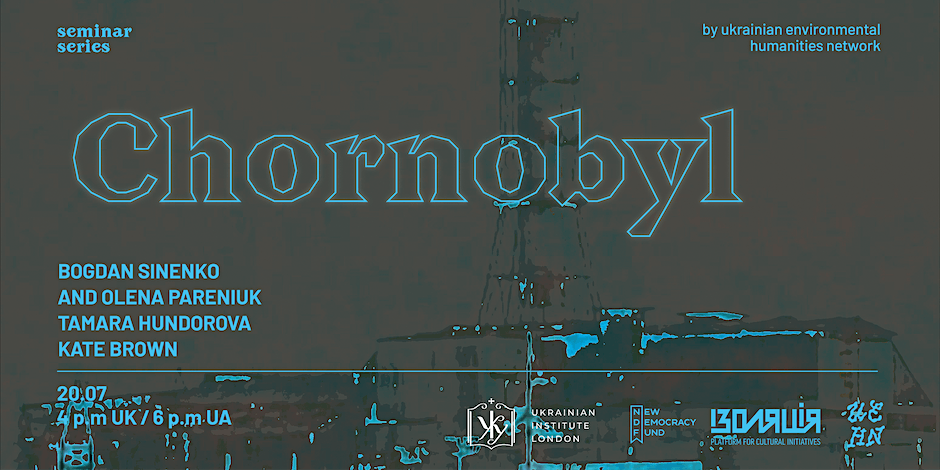Chornobyl

In the fourth seminar, it was discussed the ongoing cultural and environmental consequences of the Chornobyl nuclear catastrophe from diverse disciplines including ecology, Ukrainian literature, anthropology, environmental history, and geography. It was joined by Olena Pareniuk and Bohdan Sinenko, Tamara Hundorova, and Kate Brown.
How the Chornobyl Exclusion Zone could help us reach the stars
Terrestrial analogues are places on Earth that, due to their extreme circumstances, show certain similarities to other planets. The Chornobyl Exclusion Zone has many sites with different levels of radionuclide contamination, forming elevated doses of external irradiation. The most promising place could be the Chornobyl Nuclear Power Plant Sarcophagus, located inside the New Safe Confinement, which contains areas with his exposure, including gamma-rays and high-energy neutrons. In this regard, it can be useful as a testing ground for various technologies that will be used in an environment with high ionizing radiation levels. As well as be a source of benefit to radioresistant species of plants and microorganisms.
Dr. Olena Pareniuk is a senior researcher at the Institute for Safety Problems of Nuclear Power Plants of the National Academy of Science of Ukraine with over ten years of experience in radiobiology and nuclear safety. Specialising in Chornobyl Exclusion Zone and 4th Power Unit of Chornobyl NPP microbiology investigation and microbiome exploration.
Bogdan Sinenko is a PhD student at the National University of Life and Environmental Sciences of Ukraine with over five years of experience in space radiobiology and material science. Specializing in the effects of space radiation on plants and Mars terraforming problems.
The Chornobyl-tour: staging the catastrophe
In the process of touristification and gradual commercialisation, the Chornobyl Exclusion Zone is actively transforming into a tourist zone. Various types of tourism are now associated with Chornobyl, including heritage tourism, disaster tourism, and dark tourism. On the whole, the Chornobyl zone becomes a cultural project that acquires symbolic meanings (the collapse of the Soviet Union, the nuclear apocalypse, Thanatopolis, etc.). This is due to the permanent re-imagining of the place. The purpose of the presentation is to discuss the permanent transformation of the Chornobyl zone and analyze the possibility of its transformation through verbal and visual storytelling.
Professor Tamara Hundorova is a Principal Research Scholar at the Shevchenko Institute of Literature (Kyiv) and Associate Fellow at HURI. Currently, she is a Research Scholar and Lecturer at Princeton University and a member of PEN Ukraine. Hundorova is the author of several books and academic articles on modernism, postmodernism, gender studies, postcolonial studies, and the history of Ukrainian literature. Her most recent book The Post-Chornobyl Library: Ukrainian Postmodernism of the 1990s was co-published by Academic Studies Press and Harvard Ukrainian Research Institute.
The Great Chornobyl Acceleration: Environment and Health in the Nuclear Age
What do we know about the Chornobyl disaster? Working through Soviet archives, historian Kate Brown encountered many contradictory accounts of the catastrophe and its effects. Local doctors reported “a public health disaster” among people exposed to Chernobyl fallout. International experts refuted that claim. Realizing that although people and archives lie, trees probably don’t, Brown turned to scientists—biologists, foresters, physicians, and physicists—to help her understand the ecology of the greater Chornobyl territories. She learned that contaminants saturated local ecosystems long before the Chornobyl accident and continued long after the 1986 event. Brown argues that to call Chornobyl an “accident” is to sweep aside the decades of radiation exposure that rained down on the globe during the period of nuclear testing. Instead of a one-off accident, Brown argues that Chornobyl was a point of acceleration on a timeline of radioactive contamination that continues to this day.
Professor Kate Brown Kate is Thomas M. Siebel's Distinguished Professor in History of Science at the Massachusetts Institute of Technology. Brown’s research interests illuminate the point where history, science, technology and bio-politics converge to create large-scale disasters and modernist wastelands. She has written four books about topics ranging from population politics, linguistic mapping, the production of nuclear weapons and concomitant utopian communities, the health and environmental consequences of nuclear fallout from the Chornobyl disaster to narrative innovations of history writing in the 21st century. Her latest book — Manual For Survival — is an award-winning environmental history of the Chornobyl catastrophe.
The Ukrainian Environmental Humanities Network was launched in 2022 by Dmytro Chepurnyi, Karolina Uskakovych, Jonathon Turnbull, Oleksandra Pogrebnyak, and Ewa Sułek. The network brings together scholars, researchers, artists, curators, designers, scientists, and more who are interested in Ukraine's more-than-human landscapes and ecologies.
The project is implemented with support from the New Democracy Fund implemented by the Danish Cultural Institute.